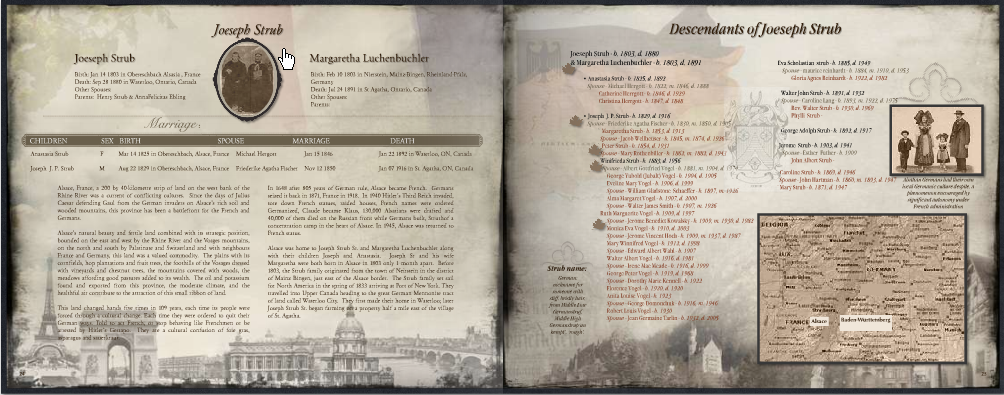One.
Stories – Your stories can come in a variety of forms. They may be a collection narrative nonfiction short stories about a variety of ancestors. You may choose to write a longer form story taking the reader through an epic adventure based on one ancestor, a couple or a surname line. 
Two.
Profiles – You can include ancestor profiles in your book to give your reader a snapshot look into an ancestor. Use profiles when you have too many gaps in your research to tell their whole story. If the ancestor has a great story, they are an interesting person, but they are not directly part of your main narrative consider writing a profile in the sidebar or give them a single on off page. This page is dedicated to a great-uncle who died at Passchendaele in WWI. He wasn’t directly part of the story, but we felt the need to honour him.
Three.
Pedigree Charts – Pedigree charts can serve the readers as a beautiful big picture view of their family history. If you are covering several surname lines in a book, consider including one for each.
Four.
Group Sheets –Each time you start a new family, a group sheet a is a great way to give the reader a big picture view. You can also include some smaller details and facts on the group sheets. By making sure all these details are on the group sheet, you won’t feel required to cram it all into the story. The story can then be a story and not a collections of facts woven together.
Five.
Descendants Chart – The descendant’s chart can help you to include the children of a couple, along with their spouses and children. This conveys a lot of information that may not be part of the direct line you are writing about but still expresses your research and can be an excellent resource for the family.
Six.
Pictures – Choose pictures that enhance your story and show your ancestors in various stages of their life. Unfortunately, not everyone will take the time to read the stories. Sigh.
Seven.
Picture Collage – Consider creating a picture collage, it can demonstrate a life without words.
Eight.
Documents – Choose poignant documents that reveal essential turning points in your ancestor’s life. Passenger lists, land document, will. Don’t feel obligated to include every census and vital record you have uncovered only the ones that were critical to the direction of your family history. If you wish to share the rest of your research and documents, save them to a cd and insert in the back of your book.
Nine.
Sources – Don’t forget to include your sources. While footnotes may not be ideal for an Heirloom Family History Book, you can still add a list of sources at the end of your book referencing the page numbers and quote the line of the fact. You can also add your list of sources to the cd if you want to keep a clean look to your heirloom book.
Ten.
Current Family – Don’t forget to include your present family in your book. If they are in it and they can see their connection to the past they are more likely to take up interest and buy your book.




Thank You! Thank You! You always give me that extra boost to get me back on track. These tips were made just for me.